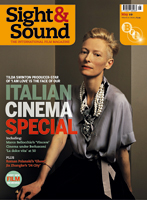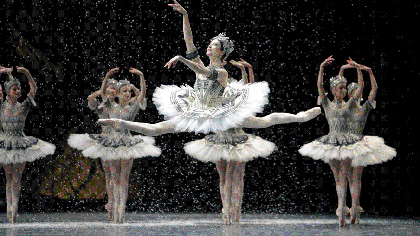Primary navigation

France/USA/Japan/Finland 2009

Reviewed by Kate Stables
Our synopses give away the plot in full, including surprise twists.
Palais Garnier, Paris, 2008. The Corps de Ballet, soloists and principals of the Paris Opera Ballet intensely rehearse the season’s programme. Choreographer Pierre Lacotte schools the company in his revival of Paquita; choreographer Wayne McGregor works through his athletic Genus with Marie-Agnès Gillot, Benjamin Pech and others; Mats Ek’s The House of Bernarda Alba is also coming together. The Corps de Ballet and soloists prepare The Nutcracker, and we also watch Orphée and Eurydice and Romeo and Juliet in rehearsal. Angelin Preljocaj works on characterisation with the dancers who will star in his Le Songe de Médée. In between these sequences, artistic director Brigitte Lefèvre meets with dancers and a new choreographer; she consults with fundraisers and holds a company meeting about new pensions negotiations. We also see the building’s backstage crew hard at work. Finally, the rehearsed sequences are seen in performance.
Institutions are the venerable and prolific documentarian Frederick Wiseman’s stock in trade. Since the long-banned Titicut Follies (1967), he’s been turning his level, rigorously unsentimental eye on a huge variety of American institutions through 30-plus films, from high school, zoo, department store and the army to an intensive-care unit in the immersive six-hour Near Death (1989).
Since so much of Wiseman’s work has quietly nailed organisations as either dysfunctional, morally careless or simply swamped by the social problems they face, La Danse’s close, appreciative, often exhilarating picture of the Paris Opera Ballet working at the peak of its powers feels like a departure for him. He’s ridden shotgun with a dance company before – tracking the American Ballet Theatre for Ballet (1995) – and he examined another iconic French troupe at length in La Comédie-Française ou L’Amour joué (1996). La Danse reflects themes from both films. This superb, utterly engrossing piece manages to dissect both an institution and an artform with extraordinary skill and beauty.
Wiseman confesses himself fascinated by the evanescence of dance, and the film focuses closely on the total consecration of both dancers and company to creating the transient beauty of performance and honing it to excellence. How do they do it? Work, is the short answer. The meat of La Danse consists of layer after layer of closely observed rehearsals for the seven pieces of the 2008 season, which range from the modern athleticism of Wayne McGregor’s Genus, through the demandingly expressive Le Songe de Médée, to the traditional classicism of The Nutcracker and Paquita, with their rigorously drilled set pieces. Wiseman, his camera mysteriously invisible in the studio mirrors that refract the dancers, concentrates closely on the repetitive working-out of steps and sequences, as choreographers and dancers bind together in a chivvying, relentless search for perfection.
Wiseman’s trademark cinéma vérité style – which has no truck with voiceovers, captions or score, no timescale or protagonist, no narrative laid out – keeps our attention usefully, hypnotically locked on the dancers’ bodies. Watching star Laetitia Pujol fail repeatedly to perform a step (“She imagines an arabesque where there is none,” snickers her partner) or seeing Marie-Agnès Gillot and Benjamin Pech trying endless variations on the fiendish contortions of Genus with its maker, the film becomes a paean not just to the discipline of the dancers but to the process of development. One that involves the entire building, whose costume-makers and lighting crew appear as single-minded as the agile, steely artistic director Brigitte Lefèvre, who insists that “everyone must unite around the work.” Granted, those Wisemaniacs who prize the comédie humaine aspects of his work, the absurdities, grimness or memorable grotesqueries (Primate'’s monkey masturbator, say) may be perturbed by the absorbed approval of its subject that the film emanates. But it’s no documercial, since Wiseman is alert to the fiercely hierarchical nature of the organisation (where the only black people glimpsed are cleaners or painters, their rhythmic movements echoing those of the dancers), to the pressures on an ageing dancer pleading for fewer roles or a young one crippling herself with self-doubt. This is a portrait of a human hive, and there’s even, fittingly, a beehive on the roof, which the film visits with the same intense stare it gives to pools of light on the long dark corridors of the Palais Garnier.
Wiseman’s concentration (and ours) pays off thrillingly once we finally see the dancers perform, shot seamlessly from the wings and stalls, the rote and wrangling of rehearsal adding layers of meaning. On stage, he shows how performance makes the dancer’s body uniquely eloquent, with the sinuous Genus pas de deux closing a circle that began with Wayne McGregor’s deliciously inarticulate ‘da-da-da-oumfh’ instructions to a bemused ballerina. The tour de force however is Médée, which choreographer Angelin Preljocal has painstakingly encouraged his dancers to put their own imprint on. Wiseman captures Delphine Moussin’s dazed murderess, awash with buckets of blood, creating something gloriously visceral and unexpected, prowling on all fours to her children’s corpses. La Danse, which has patiently unwrapped and illuminated the months of unremitting toil behind every piece, captures the moment when the work becomes transfigured, as dazzlingly as any prima ballerina.
Seeing red: restoring ?The Red Shoes? by Ian Christie (August 2009)
Center Stage reviewed by David Jays (December 2000)
Billy Elliot reviewed by Claire Monk (October 2000)